
The Tironensian Order or the Order of Tiron was a medieval monastic order named after the location of the mother abbey in the woods of Thiron-Gardais in Perche, some 35 miles west of Chartres in France). They were popularly called "Grey Monks" because of their grey robes, which their spiritual cousins, the monks of Savigny, also wore.

Vitalis of Savigny was the canonized founder of Savigny Abbey in Manche and of the Congregation of Savigny (1112).
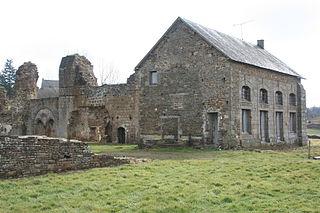
The monastic Congregation of Savigny started in the abbey of Savigny, situated in northern France, on the confines of Normandy and Brittany, in the Diocese of Coutances. It originated in 1105 when Vitalis of Mortain established a hermitage in the forest at Savigny in France.
St Mary's Abbey, also known as Malling Abbey, is an abbey of Anglican Benedictine nuns located in West Malling, Kent, England. It was founded around 1090 by Gundulf, Bishop of Rochester and dissolved in 1538. The site became a monastery again in the late 19th century.

The Abbey of Sainte-Trinité, better known as the Abbaye aux Dames, is a former Benedictine nunnery in Caen, Normandy, now home to the Regional Council of Normandy. The complex includes the Church of Sainte-Trinité.
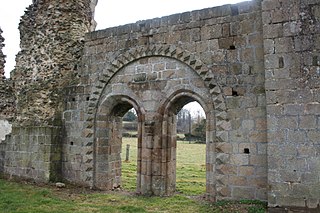
Savigny Abbey was a monastery near the village of Savigny-le-Vieux (Manche), in northern France. It was founded early in the 12th century. Initially it was the central house of the Congregation of Savigny, who were Benedictines; by 1150 it was Cistercian.

La Trappe Abbey, also known as La Grande Trappe, is a monastery in Soligny-la-Trappe, Orne, France. It is known for being the house of origin of the Trappists, to whom it gave its name.

The Abbey of the Holy Trinity at Fécamp, commonly known as Fécamp Abbey, is a Benedictine abbey in Fécamp, Seine-Maritime, Upper Normandy, France.
St. Cecilia's Abbey, Solesmes is a Benedictine convent, founded in 1866 by Dom Prosper Guéranger, the restorer of Benedictine life in France after the destruction of the revolution. It is located in Solesmes, Sarthe, and is the women's counterpart of Solesmes Abbey.

Soleilmont Abbey is an abbey of Trappistine nuns situated in the forest and commune of Fleurus, at Gilly near Charleroi, Belgium, founded, according to tradition, in the 11th century, which became Cistercian in 1237. The nuns were expelled as a consequence of the French Revolution in 1796, but soon re-established themselves in 1802. The community became Bernardine in 1837, and Trappist in 1919.
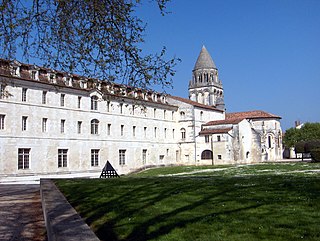
The Abbaye aux Dames was the first Benedictine nunnery in Saintes in Charente-Maritime in France. The abbey was founded in 1047 by Geoffrey II, Count of Anjou, and his wife Agnes. Agnes later retired to the nunnery and died there.
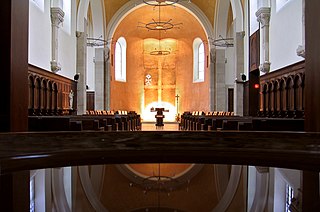
Jouarre Abbey is a Benedictine abbey in Jouarre in the département of Seine-et-Marne.

St Cecilia's Abbey, Ryde is an abbey of Benedictine nuns in the Isle of Wight, England.

Maubuisson Abbey is a Cistercian nunnery at Saint-Ouen-l'Aumône, in the Val-d'Oise department of France. It was founded in A.D. 1236 by Blanche of Castile, Queen of France, who may have been buried there in 1252. The site is now within the north-western suburbs of Paris. The surviving buildings are listed as a monument historique.

Nivelles Abbey is a former Imperial Abbey of the Holy Roman Empire founded in 640. It is located in Nivelles, Walloon Brabant, Belgium.

The Abbey of St. John, Laon was a Benedictine monastery in Laon, France, from 1128 to 1766, which replaced a nunnery founded in 641. The prefecture of the department of Aisne now occupies the site.
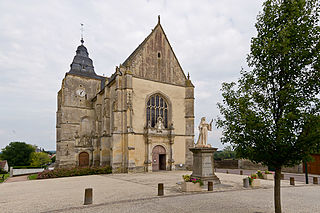
Almenêches Abbey was a Benedictine nunnery at Almenêches in Orne, Normandy, France. It was founded in the 6th century, but had been abandoned by the 10th century. Roger of Montgomery refounded it sometime between 1063 and 1066.

Montivilliers Abbey is a former Benedictine nunnery, founded between 682 and 684 by Saint Philibert in the town of Montivilliers in Normandy, in the present department of Seine-Maritime, France. It was suppressed during the French Revolution, but many buildings, including the church, have survived.















